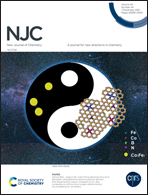Investigation of NH3 absorption by protic imidazolium thiocyanate-based deep eutectic solvents with multiple binding sites and low viscosity
Abstract
Ammonia (NH3) is not only an important basic chemical raw material but also a typical polluting gas. The separation and recovery of NH3 from tail gas is of great significance for human health and the environment. In this study, a series of protic ionic liquid-based deep eutectic solvents (PIL-based DESs) were constructed by pairing imidazolium thiocyanate ([Im][SCN]) as the hydrogen-bond acceptor (HBA) with various hydrogen-bond donors (HBDs) [glycerol (Gly), ethylene glycol (EG), formamide (FM), acetamide (AT), and caprolactam (CL)]. Their physical properties and NH3 absorption performance were systematically investigated. The results showed that [Im][SCN] played a role in chemical NH3 absorption in the PIL-based DESs, while the HBDs mainly contributed to physical NH3 capture. HBDs containing hydroxyl groups demonstrated an evident improvement in NH3 absorption capacity compared to those with amide groups. [Im][SCN]–EG (1 : 3) demonstrated the highest mass capacity of 0.233 g NH3/g DES, which exceeded those of all the other IL-based DESs and originated from the multiple interactions between the acidic H as well as the hydroxyl groups in the DES and NH3, according to the 1H NMR and FTIR spectral analysis. Furthermore, [Im][SCN]–EG (1 : 3) indicated a high NH3/CO2 selectivity of 632.2, satisfactory thermal stability and excellent recyclability. [Im][SCN]–EG DESs possess great potential as attractive absorbents in NH3 separation and recovery.



 Please wait while we load your content...
Please wait while we load your content...